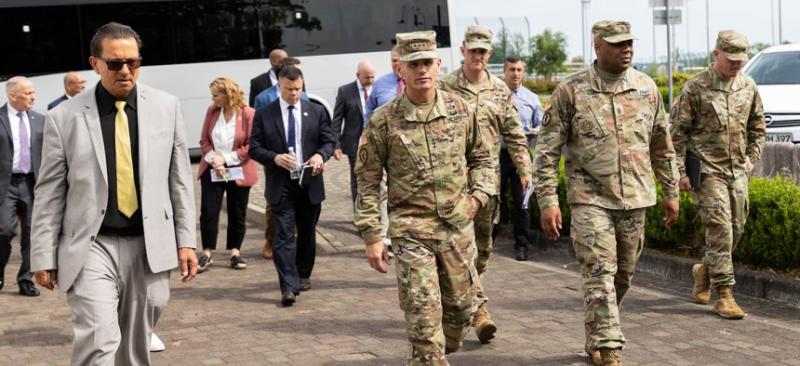The Army is too top-heavy
By: R.D. Hooker, Jr. (Defense One)


Modern military planning expends a lot of time covering it's brass. The amount of deadwood has proliferated across all uniformed branches of service except, possibly, the Coast Guard.

With its many missions, the U.S. Army is hard-pressed to meet the requirements of the National Defense Strategy at its current authorized end strength. A major part of the problem is that the Army is awash in staffs, many of which did not exist during World War II, or even in the 1990s. After 9/11, the Army Staff grew by 60 percent, while headquarters and staffs Army-wide ballooned. All of these headquarters consume resources withheld from the warfighting Army. Nor can it be shown that Army functions are being executed more effectively or efficiently because multiple large headquarters have been created to run them.
A case in point is the Army Installation Management Command, or IMC, created in 2006 and chartered to "reduce bureaucracy, apply a uniform business structure to manage U.S. Army installations, sustain the environment and enhance the well-being of the military community." IMC is headed by a lieutenant general, with a major general as deputy and brigadier general as chief of staff. IMC includes a workforce of 30,000 soldiers and 70,000 civilians. Formerly, Army installations were managed by garrison commanders reporting to local commanding generals, with an Assistant Secretary of the Army for Installation Management. In theory, centralizing the installation management function promised common standards and greater expertise. In practice, results have fallen far short, with the Army experiencing a "crisis" in installation management in recent years.
Another compelling example is the Army Acquisition Corps, created in 1989 and today employing 1,600 commissioned officers plus many more senior civilians. Since its creation, the Army has failed badly with major program acquisitions, squandering billions on programs like the Crusader Field Artillery System, the Future Combat System, the Ground Combat Vehicle, the RAH-66 Comanche helicopter and the XM1299 Extended Range Cannon Artillery system, among others. No major Army program has been successfully fielded since the 1980s, a trend described by one Secretary of the Army as a "tale of failure." In 2018, the Army doubled down by creating Futures Command, adding another large 4-star headquarters to supervise an existing, labyrinthine set of acquisition headquarters which includes the Army Futures and Concepts Center, the Army Combat Capabilities Development Command and its associated battle labs, the Army Research, Development and Engineering Command; and the Army Materiel Systems Analysis Activity, among others. Despite this massive infrastructure, the Army has not improved performance in this key sphere.
Growth in staff size and the proliferation of unneeded headquarters is accompanied by a strong tendency to "over-officer" the force, one factor in the explosion of personnel costs since 9/11. In 2024, one in six soldiers is a commissioned officer (a 21 percent increase since 2000). About one-third of the Army's personnel budget goes to officer pay and allowances. Between 1965 and 2018, the number of general and flag officers in the U.S. military as a percentage of the total force increased by 46 percent; of 4-stars by 114 percent; and of 3-stars by 149 percent. Such deliberate rank-inflation and over-staffing contributes to a bureaucratic culture that demands constant reporting from junior commanders, so much so that one authoritative Army War College study found a "suffocating amount of mandatory requirements" they are "literally unable to complete…forcing them to resort to dishonesty evasion." Almost certainly, this environment contributes to an exodus of young officers who are frustrated by crushing administrative burdens they cannot reconcile with their duty to train their soldiers for war.
In short, the Army should shutter those organizations not deemed essential, reduce the officer-to-enlisted ratio, and streamline its bloated staffs. These measures will increase the number of billets available to operational units, decrease unnecessary reporting requirements on them, reduce personnel costs and increase the productivity and efficiency of those headquarters that remain. Leaner and flatter are watchwords in the private sector—and are clearly priorities for the incoming administration. America's Army should adopt them as well.
Dr. Richard D. Hooker, Jr. is a Senior Fellow with The Atlantic Council and a Senior Associate with the Harvard Kennedy School Belfer Center. He previously served as The Theodore Roosevelt Chair in National Security Affairs at the National Defense University and as University Professor at NDU's National War College.





Diversity, equity, and inclusion (DEI) has been a boon for military officers who serve no military purpose. Is this why our national security has come to rely upon special forces? 5% of our forces do the fighting on the ground and the rest are engaged in planning ,support roles, and preparing appropriations requests?
Are there any government entities that aren't top heavy?
“Are there any government entities that aren't top heavy? “
Just the incoming administration, less top heavy in being populated by bottom feeders…